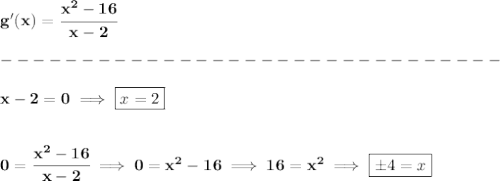
Mathematics, 31.08.2019 13:30 kromer6797
Let g be a function that is defined for all x, x ≠ 2, such that g(3) = 4 and the derivative of g is
g′(x) = quotient of quantity x squared minus sixteen and x minus two with x ≠ 2.
find all values of x where the graph of g has a critical value.
for each critical value, state whether the graph of g has a local maximum, local minimum, or neither. you must justify your answers with a complete sentence.
on what intervals is the graph of g concave down? justify your answer.
write an equation for the tangent line to the graph of g at the point where x = 3.
does this tangent line lie above or below the graph at this point? justify your answer.


Answers: 2


Another question on Mathematics

Mathematics, 21.06.2019 19:00
Use the quadratic formula to solve the equation. if necessary, round to the nearest hundredth. x^2 - 8 = -6x a. –7.12, 1.12 b. 7.12, –1.12 c. 7.12, 1.12 d. –7.12, –1.12
Answers: 2

Mathematics, 21.06.2019 19:30
Identify the number 127 as a rational or irrational. explain
Answers: 2

Mathematics, 21.06.2019 22:00
(01.04 lc)multiply 1 over 6 multiplied by negative 1 over 2. negative 1 over 3 negative 1 over 12 1 over 12 1 over 3
Answers: 1

Mathematics, 21.06.2019 23:00
The equation shown below represents function f. f(x)= -2x+5 the graph shown below represents function g. which of the following statements is true? a. over the interval [2, 4], the average rate of change of f is the same as the average rate of change of g. the y-intercept of function f is less than the y-intercept of function g. b. over the interval [2, 4], the average rate of change of f is greater than the average rate of change of g. the y-intercept of function f is greater than the y-intercept of function g. c. over the interval [2, 4], the average rate of change of f is the same as the average rate of change of g. the y-intercept of function f is greater than the y-intercept of function g. d. over the interval [2, 4], the average rate of change of f is less than the average rate of change of g. the y-intercept of function f is the same as the y-intercept of function g.
Answers: 1
You know the right answer?
Let g be a function that is defined for all x, x ≠ 2, such that g(3) = 4 and the derivative of g is...
Questions


Mathematics, 05.06.2020 05:57

Social Studies, 05.06.2020 05:57

Geography, 05.06.2020 05:57

Mathematics, 05.06.2020 05:57




English, 05.06.2020 05:57

World Languages, 05.06.2020 05:57

English, 05.06.2020 05:57

Mathematics, 05.06.2020 05:57

Mathematics, 05.06.2020 05:57


Health, 05.06.2020 05:57



Mathematics, 05.06.2020 05:57


Mathematics, 05.06.2020 05:57







